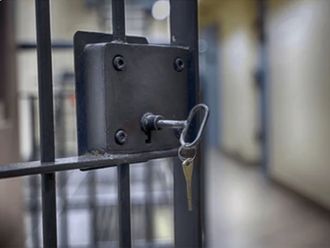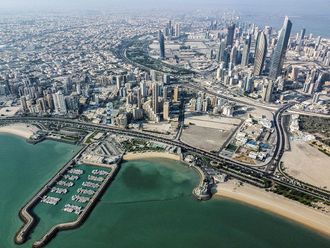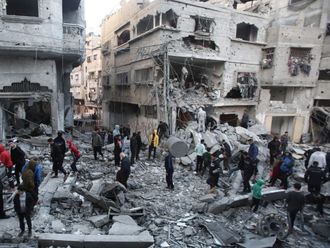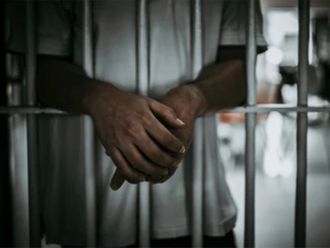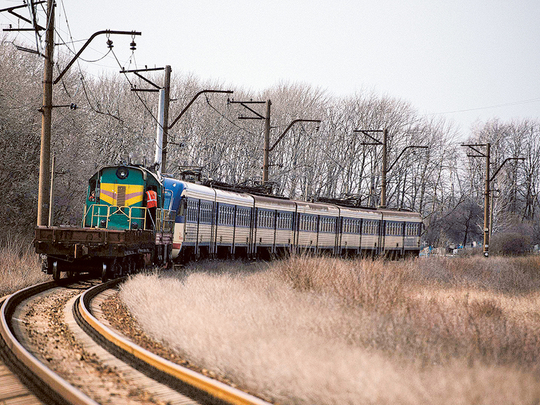
Yasynuvata, Ukraine: In the conflict-torn eastern Ukraine town of Yasynuvata, residents are overcoming their fear and boarding a popular local train for the first time in many months, spurred by the chance to see loved ones.
The rail link between Yasynuvata and the city of Lugansk, both controlled by pro-Russian separatists, reopened on Saturday following a seven-month break, as a fragile ceasefire signed last month between the rebels and the Ukrainian authorities continued to hold.
The lull in fighting has finally allowed for the repair of rails, power lines and stations damaged in August last year, at the height of the hostilities.
After days and nights spent in cellars seeking refuge from the bombing, a train ride is a cause for celebration. Even if the “blue train” — so called because of its colour — is fronted by an anti-mine carriage, scanning the tracks for explosives.
“I am very, very happy! I haven’t seen my mother for a year,” said Yelena Panova, her eyes bright with excitement.
“I’m so glad, I hope the journey never ends!” she added, clutching an imitation snakeskin bag.
Panova, who works at a sausage factory, came loaded with insulin, meat and tinned food for her 75-year-old diabetic mother, who lives around halfway through Lugansk.
“Thanks to the train, I will also be able to visit the family cemetery before Easter,” said the 51-year-old.
Many Orthodox believers in the former Soviet Union keep a tradition of visiting family graves at Easter.
“I’m afraid of the shooting, but I hope it will all go OK,” Panova said. “My husband stayed at home and is very worried about me.”
At times, the train passes just a few kilometres from the front line, covering a distance of around 140 kilometres that normally takes about three hours.
Semyon Kuzmenko, transport “minister” of the rebels’ self-declared Donetsk People’s Republic, was on hand at the platform in Yasynuvata to reassure nervous travellers.
A few seats away from Panova, Alexander Zavgorodny, 42, revealed his desperation to get to Lugansk and see his wife and his son, who has just turned 11.
“I haven’t seen them for two months, and before that it was six months because they were seeking refuge in (the government-controlled city of) Odessa,” said the truck driver, explaining that the alternative bus journey was time-consuming and dangerous.
Rail staff Lyudmila, Viktoriya and Yelena have waited seven months to put on their uniforms again.
There may only be a dozen passengers, but the women are just relieved to be back at work, even waving through a passenger who has arrived ticketless.
“Our lives have resumed,” said 54-year-old Lyudmila, a 20-year veteran of the ticket office.
“It has been very difficult, and of course we are afraid about the safety of line, like everyone else,” she added.
A sombre silence descends on the carriage as the train winds its way through the scarred landscape, past metallurgical plants pumping out white smoke, bombed-out homes and dead trees.
An hour-and-a-half into the trip, suspicious noises force the train to stop. Anxiety grips the carriages as the train backtracks.
Sergei, the driver, marches out of the cab, cap on his head and cigarette butt hanging from his lips. The train, it turns out, is too high to connect properly with the overhead power lines on this section of the tracks.
“We tried the journey yesterday [Friday] with a locomotive, but the train is not the same size,” he explained.
“I expected a problem like this, it’s normal. It will be repaired,” he added.
“I know that today I am not just the train driver. It is essential that I don’t disappoint all these people.”
After a short wait, the problem is fixed and the passengers continue their journey, wracked by nerves.
Approaching the separatist-controlled town of Vuglegirsk, around 35 kilometres from the start point, people come out to greet the train while smiling children frantically wave at the passengers.
It is clear that for them, getting this symbol of normality back on the rails has been worth the effort.





